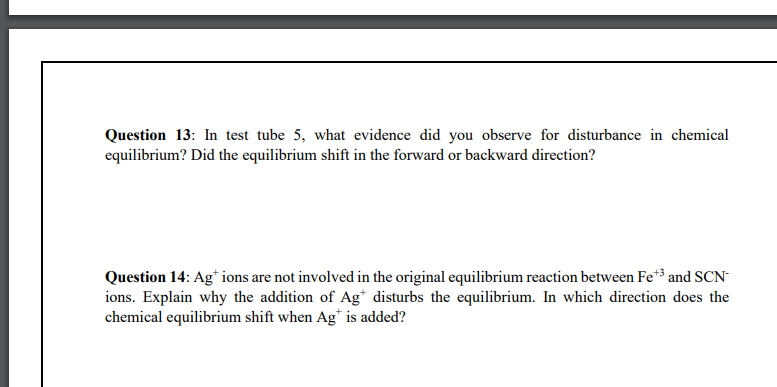3. Changing Reaction Equilibrium Conditions - Le Chatelier's Principle 3A. Effect of Changing Reactant Concentration Is intensity of red color darker Is [Fe(SCN)]** or lighter compare to the reference test tube color Test tube Color of solution increased or decreased? 1. Reference Blood red color 2. Fe* added Dark blood red darker | color Dark blood red darker | color Light Blood red lighter color 3. SCN¯ added 4. Fe* removed by adding CI | 5. SCN removed Light blood red lighter by adding Ag* | color Question 10: With the addition of more Fe*³ ions in test tube 2, did the reaction equilibrium move towards reactants or products? Explain. Question 11: With the addition of more SCN' ions in test tube 3, did the reaction equilibrium move towards reactants or products? Explain. Question 12: The addition of Cl ions in test tube 4 shifts the equilibrium in the backward direction. Explain how.
Ideal and Real Gases
Ideal gases obey conditions of the general gas laws under all states of pressure and temperature. Ideal gases are also named perfect gases. The attributes of ideal gases are as follows,
Gas Laws
Gas laws describe the ways in which volume, temperature, pressure, and other conditions correlate when matter is in a gaseous state. The very first observations about the physical properties of gases was made by Robert Boyle in 1662. Later discoveries were made by Charles, Gay-Lussac, Avogadro, and others. Eventually, these observations were combined to produce the ideal gas law.
Gaseous State
It is well known that matter exists in different forms in our surroundings. There are five known states of matter, such as solids, gases, liquids, plasma and Bose-Einstein condensate. The last two are known newly in the recent days. Thus, the detailed forms of matter studied are solids, gases and liquids. The best example of a substance that is present in different states is water. It is solid ice, gaseous vapor or steam and liquid water depending on the temperature and pressure conditions. This is due to the difference in the intermolecular forces and distances. The occurrence of three different phases is due to the difference in the two major forces, the force which tends to tightly hold molecules i.e., forces of attraction and the disruptive forces obtained from the thermal energy of molecules.
question 13 and 14
![3. Changing Reaction Equilibrium Conditions - Le Chatelier's Principle
3A. Effect of Changing Reactant Concentration
Is intensity of red color darker Is [Fe(SCN)]"
or lighter compare to the
2+
Test tube
Color of solution
increased or
reference test tube color
decreased?
1. Reference
Blood red color
2. Fe3+ added
Dark blood red darker
color
3. SCN added
Dark blood red darker
color
4. Fe* removed
by adding Cl
5. SCN removed Light blood red lighter
by adding Ag*
Light Blood red lighter
color
color
Question 10: With the addition of more Fe*3 ions in test tube 2, did the reaction equilibrium move
towards reactants or products? Explain.
Question 11: With the addition of more SCN' ions in test tube 3, did the reaction equilibrium move
towards reactants or products? Explain.
Question 12: The addition of Cl ions in test tube 4 shifts the equilibrium in the backward direction.
Explain how.](/v2/_next/image?url=https%3A%2F%2Fcontent.bartleby.com%2Fqna-images%2Fquestion%2Fec37aac0-7d29-4e20-aa79-8267bb27a4fc%2F7afcd37b-a1be-4683-a573-07b3bade3418%2F3ssayy_processed.png&w=3840&q=75)

Trending now
This is a popular solution!
Step by step
Solved in 3 steps with 2 images









